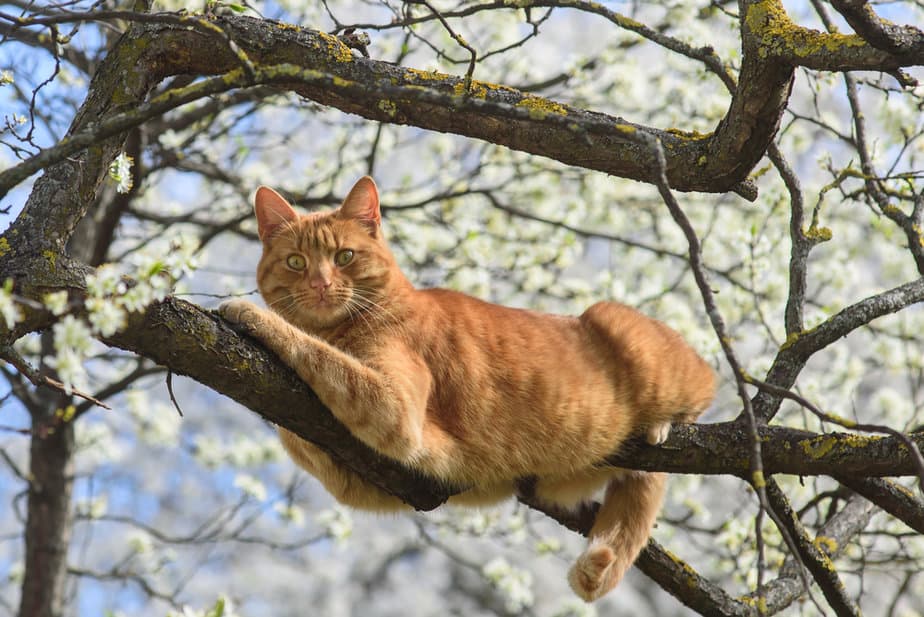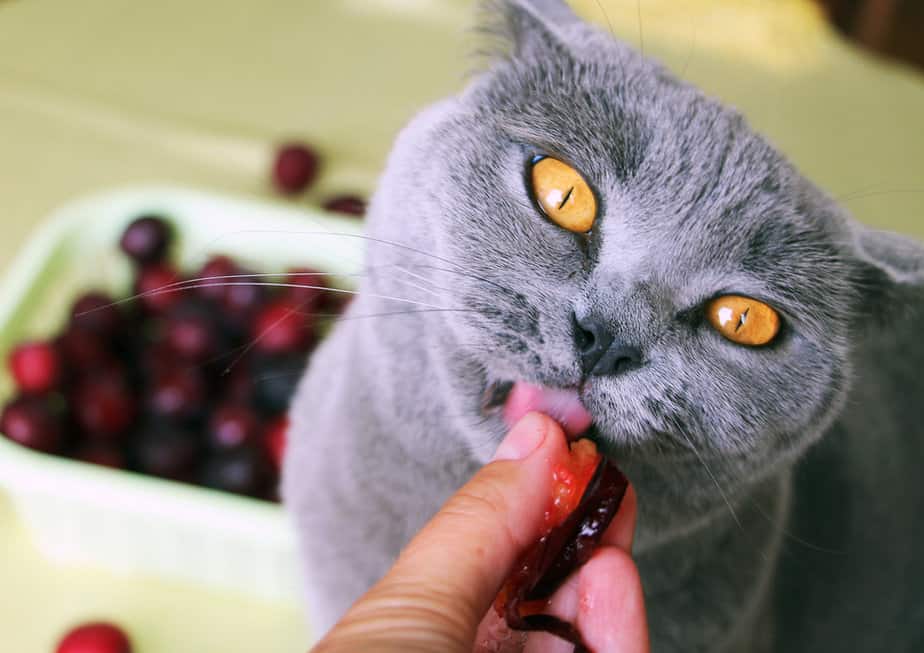“Can cats eat plums!?” you’re wondering as you’re looking at your curious creature munching on something that resembles the purple fruit. She knows you’re on to her, but she doesn’t really care because she also knows she can get away with anything as long as she gives you the look.
And don’t even act like you don’t know the look we’re talking about! The one that makes you feel like the worst pet parent in the world because you refused to let her taste your chocolate pudding (!?) after she scoffed down an entire bowl of kitty kibble.
It’s the look that makes you rethink every choice you’ve ever made that led you straight to this moment. And we can’t forget, the look that makes you wonder whether you’re the only one who doesn’t seem to know anything about your cat’s nutritional needs and wants.
You have nothing to worry about – cats are curious creatures and they don’t stray away from doing everything (and we mean everything) to get what they want. They’re like the Ariana Grande of the animal kingdom – they see it, they like it, they want it, they get it!
Going back to the point, though, can cats eat plums? According to our friends over at the ASPCA (American Society for the Prevention of Cruelty to Animals), cats absolutely can’t and shouldn’t eat plums. Certain plum parts contain cyanide which makes the fruit toxic to your curious companion.
But, before you start freaking out and getting rid of EVERY. SINGLE. PLUM your cat’s ever dreamed of munching, you might want to take a breather. Plums (their flesh, at least) aren’t the worst thing she can eat, but here’s what to expect if she does.
What’s so glum about plums?

“They’re big and small, purple and orange, with yellow and red flesh! They’re mouth-watering, paw-licking, and absolutely divine regardless of the way you prepare them! Who wouldn’t want to munch on this heavenly pitted fruit!?” said every cat ever.
And for a good reason, too! Plums are amazing when we’re talking about their versatility and diversity, but also when we’re talking about the never-seen-before nutritional and health benefits they bring to the table. What even are plums, though?
Plums are a type of stone fruit (because of the pit or “stone” in the middle of their flesh) that originated from China. They moved to Japan, parts of Europe, and America, and now they’re present pretty much everywhere throughout the world. They are super sweet and in the same plant family as peaches, nectarines, and apricots.
They’re packed with vitamins, minerals, and antioxidants that can boost your immune system, maintain the health of your nervous system, and ensure the proper function of your digestive system. Vitamins A, C, K, thiamine, riboflavin, and niacin have your systems covered to a tee.
How come cats can’t eat plums, then? Plums are pretty great, except for one pretty BIG fact – the stem, leaves, and pit of the plum contain cyanide. And unfortunately, cyanide can make your cat seriously sick, which is why this fruit is on the ASPCA’s naughty list.
Why can cats NOT eat plums?
“But, maybe cats can eat the flesh of the plum? Maybe they can have a nibble? Maybe they can have a lick?” No, cats CAN’T eat plums and there are a couple of things to consider before you start having second thoughts (or even better, before your four-legged friend starts sampling them).
Cats are carnivores, which means they need meat, animal protein, and animal nutrients to survive and thrive. They don’t need fruits, veggies, and whole grains the same way humans need them. They don’t even possess the enzymes necessary to break down most foods humans eat on a regular basis.
How’s that possible!? Well, here’s some food for thought. Wild cats spend most of their day hunting and then feeding off their prey. They scoff down pretty much everything – organs, bones, and stomach contents. That’s a natural part of their diet and their digestive systems are designed to process it.
But, not-so-wild cats spend most of their day nibbling on carefully crafted cat food and cat treats. Their digestive systems are accustomed to breaking down and processing foods that have been made for domesticated felines, so they don’t need to do that much work.
Cats can’t even taste sweet things because sweet things aren’t a natural part of their diet! Cats don’t like plums because of their taste, they like them because they’re curious. They like them because they’re cats and they like everything they can get their paws on.
But, other than being of no nutritional value to your four-legged friend, we can’t forget about the two BIGGEST reasons why cats can’t eat plums.
1. Cyanide poisoning

That’s right! We’ve brushed upon the fact that the stem, leaves, and pit of the plum contain cyanide, but you might be seeking a more detailed explanation. We’ve heard of cyanide before (let’s just say that the reputation precedes the chemical), but what makes cyanide poisonous to cats?
Here’s the thing – most fruits contain a little bit of cyanide that’s not poisonous to humans. Apricots, cherries, peaches, pears, prunes, and apples contain a minuscule amount of the chemical somewhere on them and they’re all just as poisonous to cats as plums.
Actually, these scrumptious nature candies contain cyanide glycoside, which turns to hydrogen cyanide when digested. The latter is the biggest culprit because that’s the one that makes plums so poisonous to our four-legged friends.
So, should your cat eat one too many plums, you might want to keep an eye out for some of the most common symptoms of cyanide poisoning: drooling, dilated pupils, difficulty breathing, wheezing, panting, red mucus membranes, vomiting, and diarrhea.
Contact your vet the moment that you notice any of these signs. Your vet should be able to provide your cat with proper supportive care and medication that should make your cat feel better.
2. Choking hazard
And we can’t forget about the pit of this stone fruit! Not only do the plum pits contain cyanide, but they also pose a choking hazard to your precious pet. They’re pretty small, so naturally, they can become wedged in your cat’s throat, esophagus, or anywhere throughout the digestive tract.
And we can’t forget about the skin of the plum! That’s right, the skin can become a choking hazard too, if your curious creature should chew and nibble on these parts of the plum without success. Plum’s flesh seems pretty soft and manageable, but the skin isn’t – especially not for a cat.
And don’t even get me started on the stem – chewy, hard, and small enough to get stuck pretty much anywhere.
So, what have we learned so far? Repeat after me:
Cats can’t eat plums. The stem, leaves, and pit of the plum contain cyanide and can cause harm to your cat’s health. The stem, skin, and pit of the plum can become a choking hazard. STAY AWAY FROM THE PLUM!
What to do if your cat eats a plum?

Contact your vet THE MOMENT you notice your cat munching on a plum. Don’t get me wrong, she might be completely safe, giving the plum a little lick or even a little bite. But, she might also be at risk of cyanide poisoning if she makes a wrong move and nibbles on something really, really bad.
Don’t delay in taking her to the emergency animal center at the first sign of cyanide poisoning. Keep your eyes peeled on anything ranging from drooling, dilated pupils, and difficulty breathing to red mucus membranes, vomiting, and diarrhea.
Cyanide poisoning can cause your cat to go into shock, so naturally, it’s incredibly important to stay calm and collect your thoughts. Figure out which parts of the plum she’s eaten because this can help your vet determine how much cyanide she’s consumed.
Stay positive – your cat might have to spend some time with your vet after cyanide poisoning treatment (lots of IV tubes, lots of sodium nitrate, and lots of supportive care). She might need some time to recover, but she should be as good as new once the cyanide is out of her system.
Can cats eat other fruit?
Let’s cut to the good news: Cats CAN eat other fruits!
“Oh, you’re not here to shut down every single dream I’ve ever had!? I can actually eat something delicious and NOT spend the rest of the day in and out of the litterbox!?” – you can just imagine your cat saying right about now.
Cats might not be able to munch on plums (who needs them anyway!?) but there are a bunch of other fruits they can tuck into whenever they’re looking for a pick-me-up.
We’re talking about blueberries, strawberries (and other berries), bananas, mangoes, pineapples, cantaloupes, watermelons, and even apples (minus the stem and the seeds, though). We guarantee your curious creature can find something she’ll enjoy throughout the summer.
Remember to always consult with your vet before adding new foods to your cat’s diet. Fruits like oranges, lemons, limes, and cherries can cause harm to your cat’s health, which means they have no business on your kitchen counter.
Trust me, your cat’s better off munching on cat food, cat treats, or an occasional berry or two.

